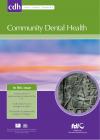Community Dental Health

- Cover Date:
- December 2010
- Print ISSN:
- 0265 539X
- Vol:
- 27
- Issue:
- 4
Salivary Streptococcus mutans level: value in caries prediction for 11-12-year-old children
Objectives: To analyze the associations of salivary Streptococcus mutans (SM) level with caries experience and incidence in children. Methods: Five hundred 11-12-year-old children participated in this study, one year later at follow-up 485 children remained. Scores of decayed, missing or filled (DMF) indices were recorded according to WHO criteria at baseline and at follow-up. Baseline salivary SM concentrations were determined with species-specific monoclonal antibodies. Results: Pearson’s correlation coefficient for SM concentration and DMFS at baseline was 0.14 (P=0.002), for SM concentration and DMFS increment was 0.22 (P<0.001), for baseline DMFS and caries increment was 0.39. Salivary SM concentration was divided into three categories (scoring 1-3 respectively): 0.01-3, 3.01-25, and >25×104/ml. Compared with children who were classified as category 1, children in category 2 were approximately twice as likely to develop new carious lesions (relative risk=1.83), whereas those in category 3 were about three times as likely (relative risk=2.67). However, caries prediction based on salivary SM levels provided negative predictive values (0.770~0.839) much higher than positive predictive values (0.341~0.436). Conclusions: Salivary SM level associates positively with caries experience, caries incidence and increment. Caries prediction solely relied on salivary SM levels is not recommended. However, such test may help to identify those at risk children who have not been affected by caries yet.
Key words: Dental caries; risk assessment; Streptococcus mutans
- Article Price
- £15.00
- Institution Article Price
- £
- Page Start
- 248
- Page End
- 252
- Authors
- X. Hong, D.Y. Hu
Articles from this issue
- Title
- Pg. Start
- Pg. End
- Editorial - Improvement of global oral health - the leadership role of the World Health Organization
- 194
- 199
- Trends in childrens’ ability to consent to a dental examination and the potential impact on reported caries indices
- 200
- 205
- Tooth surface loss, prevalence and associated risk factors among 12-14 years school children in Khartoum State, Sudan
- 206
- 212
- Trends in dental caries experience among children and adolescents in northern Poland between 1995 and 2003.
- 218
- 221
- Five-year follow-up of oral health and seizure condition of patients with epilepsy: a prospective observational study
- 233
- 237
- Distribution of certain types of occlusal anomalies among Saudi Arabian adolescents in Jeddah city
- 238
- 241
- Short Communication - The quality of reporting of randomised controlled trials in dental public health
- 253
- 256
